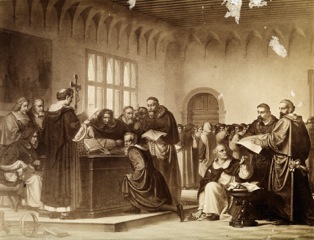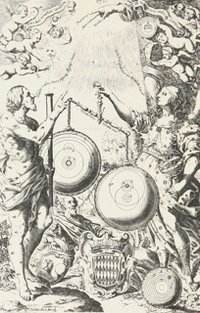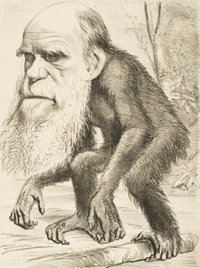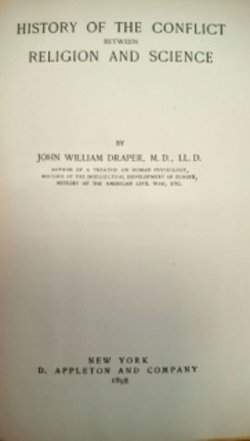The Myth of a Perennial Battle between Science and Religion
Peter Harrison
400 years ago, on 25 February 1616, Galileo was enjoined by the Catholic authorities to abandon the Copernican hypothesis. The idea that the earth was in motion around the sun was declared to be scientifically ‘foolish and absurd’ and ‘formally heretical’. As is well known, Galileo was reluctant to renounce this new theory and eventually, in the now infamous trial of 1633, was found guilty of suspicion of heresy and sentenced to imprisonment.The trial of Galileo has become emblematic of a supposedly perennial battle between science and religion.
While Galileo’s fate at the hands of the Inquisition might be the most prominent instance of this putative conflict, there seems to be plentiful additional evidence to support it—the reception of Darwin’s theory of evolution by natural selection, contemporary controversies that swirl around young earth creationism and the teaching of evolution in schools, religious objections to forms of biomedical technologies, and denunciations of religion in the name of science issued by outspoken scientific popularizers. All of these add to the common perception that recent science-religion conflicts are just the contemporary manifestation of a longstanding historical pattern.
1. The Complexities of History
What do historians of science make of such claims? Not much, as it turns out. The historical relations between science and religion have been the focus of considerable study over the past thirty years and the verdict is now in: there has been no enduring warfare between science and religion. The present consensus among historians is that there is no consistent pattern of historical relations between science and religion. If there is a single word that might characterize past relationships it is 'complexity'.
One reason for this complexity is that the disciplines were arranged very differently in the past and up until the nineteenth century there were no clear cut boundaries between what we would now call ‘science’ and religion. Medieval thinkers, for example, tended to classify theology as one of the sciences. From their perspective, speaking of a conflict between science and theology could only result from some kind of conceptual confusion, since theology was a science. Subsequently, in the seventeenth century, Isaac Newton (1642-1726/7) would declare that discussion of God was an integral part of the business of scientific investigation.
Newton's position was not uncommon at this time, when the systematic investigation of nature was often motivated by religious concerns, or was seen as providing evidence of the existence and wisdom of God. Johannes Kepler (1571-1630), whose pioneering discovery of the three laws of planetary motion provided the basis for Newton's discoveries, once declared that 'I wished to be a theologian; for a long time I was troubled, but now see how God is also praised through my work in astronomy.’ Robert Boyle (1627-1691), who lends his name to Boyle’s gas law, maintained that scientific study affords us 'Rational and Solid Grounds to believe, admire, adore, and obey the Deity.' Newton himself wrote, concerning his discovery of laws of gravity that governed the regular motions of the celestial bodies, that 'this most beautiful system of the sun, planets, and comets could only proceed from the counsel and dominion of an intelligent and powerful Being.’
In addition to motivating scientific enquiry and furnishing evidence of God's power, religious considerations could also provide the foundations of particular forms of scientific enquiry. The very idea of a 'law of nature', when first proposed in the seventeenth century, was not a mere metaphor, but was regarded as a divinely authored rule that natural objects were compelled to obey. Robert Boyle expressed it this way: 'The most Wise and Powerful Author of Nature ... did at the Beginning of Things, Frame things Corporeal into such a System, and Settles among them such Laws of Motion, as he judg'd suitable to the Ends he propose'd to Himself, in making the World.' Discovering the laws of nature, on this understanding, was really a way of investigating the mind of God.
These instances of positive connections between religion and science raise serious doubts about the claim that historical relations between them have been uniformly hostile. But do these positive examples outweigh the better known historical episodes concerning Galileo and Darwin?
2. Revisiting Galileo and Darwin
The first thing to say about the Galileo affair is that it was far from a straightforward case of science-religion conflict. Most importantly, during the seventeenth century there remained significant scientific objections to the Copernican model. Added to this was a rival new theory—the Tychonic model—that for a time seemed to be more consistent with the empirical evidence than Copernicanism. (Tycho Brahe proposed that the other planets orbit the sun, which in turn orbits a stationary earth.) This would suggest not a straightforward science-religion conflict, but a struggle between competing scientific models. Arguably, the Catholic Church backed the model that had more scientific supporters, even though in the long run that model turned out to be wrong.
It is also important to note that the Catholic Church, historically, had been the most prominent institutional supporter of astronomical research in the late medieval and early modern periods. The condemnation of Galileo was thus not a typical example of how the Church dealt with scientific matters.
As for Galileo, he remained a committed Catholic to the end of his life, his last days spent not in an Inquisition dungeon but in the relatively congenial conditions of house arrest in his villa outside Florence where he continued to receive the counsel and support of members of the religious orders. Indeed, as already hinted, virtually all the key figures of the scientific revolution were devout Christians. Most would have found any talk of an inevitable science-religion conflict deeply puzzling.
The situation with Darwin's theory of evolution through natural selection is a little more complicated. Certainly, the theory did provoke significant religious opposition when Darwin published the Origin of Species in 1859. Religious conservatives were concerned that natural selection threatened the uniqueness of human beings, their possession of an immortal soul, and eroded the foundations of morality. Moreover, even those religious figures sympathetic to Darwin were concerned by the randomness of the evolutionary process and its apparent lack of purpose and direction.
Yet for all that, Darwin did have religious supporters. The Harvard Botanist Asa Grey, a sincere Presbyterian, was Darwin's most staunch supporter in America. Gray believed that God was 'the source of all evolutionary change'. This was consistent with Darwin's own suggestion of evolutionary laws that 'may have been expressly designed by an omniscient Creator'. In England, Darwin's ideas received the backing of a number of highly placed clergymen, including the historian-novelist Charles Kingsley. Comparing the doctrine of special creation with Darwinian evolution, Kingsley concluded that the latter represented a more lofty conception of the Deity. Frederick Temple was another clerical adherent of Darwinian ideas, and his appointment as Archbishop of Canterbury in 1889 meant that the most high profile religious post in the land was occupied by a supporter of evolution. Darwin’s burial in Westminster Abbey offers the final indication of the Church of England’s sanguine attitude to evolutionary thought.
Yet tensions undoubtedly remain. Twentieth-century USA was witness to the emergence of a new form of opposition to evolutionary theory in the form of flood geology and young earth creationism. For a time, these instances of ‘scientific creationism’ were restricted to North America. But the twenty-first century has seen the export of the movement to Islamic countries and Christian populations in Africa and South America. Young earth creationism continues to be the most conspicuous manifestation of contemporary conflict between science and religion. But at the same time, it is important to remember that Roman Catholics and most mainline Protestant denominations, while less vocal, have an approach to evolution that reflects the Anglican Church’s early accommodation to that scientific theory.
3. The Origins of the Conflict Myth
If religiously motivated resistance to science (and specifically evolution) is primarily a late modern phenomenon, where did the myth of a perennial conflict originally come from?
We can identify three related phases in the development of the idea of an ongoing battle between science and religion. In the seventeenth century, Protestant apologists first implied that the Catholic Church represented a significant regressive force and one that had a history of routine resistance to new ideas. The example of Galileo was seized upon as a prime example of this. Here then, the opposition was set up not between science and religion, but science (broadly defined) and the Catholic Church. Subsequently, this tactic backfired when that opposition was broadened to include all forms of religion.
A second phase came with the emergence of the idea of progress in the eighteenth and nineteenth centuries. History came to be understood in terms of stages in which the human mind progressed from an early period of tutelage to superstitious and religious ideas to a more rational age of scientific enlightenment. Conflict was the inevitable result of religious resistance to this inexorable historical process. As the Enlightenment figure Nicolas de Condorcet expressed it in his Sketch for a Historical Picture of the Progress of the Human Spirit (1795): ‘the triumph of Christianity had been the signal for the complete decadence of philosophy and the sciences.’ Now that science was in the ascendency, Christianity continued to exert its traditional reactionary role.
Finally, the late nineteenth century witnesses the explicit formulation of the conflict narrative in the works of John William Draper and Andrew Dickson White. In 1874, Draper produced his History of the Conflict between Religion and Science in which he declared that the history of science was nothing other than ‘a narrative of the conflict of two contending powers’. White followed suit in his History of the Warfare of Science with Theology in Christendom (1896). Draper’s work continued the tradition of anti-catholic polemic, while White sought, not always successfully, to identify ‘dogmatic theology’ as the key obstacle to scientific progress. But cursory readers of these works took home the message of a historically inevitable and unqualified conflict between science and religion. Moreover, Draper and White between them compiled many of the now standard historical examples of a supposed conflict between science and religion that continue to feed the myth. As subsequent historical research has demonstrated, many of these instances are simply false; others far more complicated than unambiguous instances of science-religion conflict.
Why does the myth persist? One reason is that it seems to be consistent with contemporary instances of science and religion conflict. The myth is thus fuelled on one side by religious conservatives who oppose evolution and on the other by Darwinian fundamentalists who think that science and religion are intrinsically incompatible. Amongst the latter group are those who believe, sincerely but mistakenly, that science is the solution to religiously inspired violence and to the ‘clash of cultures’. The myth also confirms a belief in our own intellectual superiority, and the conviction that we are more advanced in every way than our superstitious forebears. Finally, the myth makes for good stories. Conflict always sells better than concord, and accounts such as the trial of Galileo provide inspirational scientific heroes that we want to believe in. Much to the chagrin of historians, then, the myth of a perennial conflict between science and religion is likely to be around for some time.
Peter Harrison
Published May 2016
We also offer a German translation of this article.
Peter Harrison is an Australian Laureate Fellow and Director of the Institute for Advanced Studies in the Humanities at the University of Queensland. Previously he was the Idreos Professor of Science and Religion at the University of Oxford where he also served as Director of the Ian Ramsey Centre. He has published extensively in the area of intellectual history with a focus on the philosophical, scientific and religious thought of the early modern period. He has been a Visiting Fellow at Yale and Princeton, is a founding member of the International Society for Science and Religion, and a Fellow of the Australian Academy of the Humanities. In 2011 he delivered the Gifford Lectures at the University of Edinburgh. Author of over 80 articles and chapters, his six books include, most recently, The Territories of Science and Religion (Chicago, 2015), winner of the 2015 Aldersgate Prize.
Further Reading
John Hedley Brooke, Science and Religion: Some Historical Perspectives (Cambridge, 2014).
Thomas Dixon, Science and Religion: A Very Short Introduction (Oxford, 2008).
Ronald L. Numbers (ed.), Galileo goes to Jail, and other myths in the history of science and religion (Harvard, 2011).
Peter Harrison (ed.), The Cambridge Companion to Science and Religion (Cambridge, 2010).
Peter Harrison, The Territories of Science and Religion (Chicago, 2015).
Picture Credits
Galileo Galilei at his trial by the Inquisition in Rome in 1633 (c) Wikimedia Commons
Frontispiece of Riccioli's 1651 New Almagest (c) Wikimedia Commons
"A Venerable Orang-outang", a caricature of Charles Darwin as an ape published in The Hornet, a satirical magazine (c) Wikimedia Commons
Title page of Draper, History of the Conflict (c) photo of the personal copy of Peter Harrison














